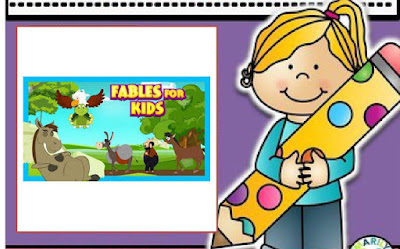Lesson Plan of Fables in English Grade V
Lesson Plan of Fables in English
Grade V
Students` Learning Outcomes
- Write a short passage, anecdote, fable, etc. for pleasure and creativity.
Information
for teachers
- In this plan only fable is taught. Passage and anecdote are discussed separately.
- All fables have animal characters (or objects sometimes), who speak and act like human beings.
- All fables have a moral (a lesson that teaches correct behavior or a universal truth.
- In a fable, you can use masculine and feminine pronouns (he/she) for the animal characters, instead of neuter (it) because no human characters are used.
- While teaching the lesson, consult textbook at all steps wherein and whenever it is required.
Material/Resources
Story
of ‘The fox and the stork’, pictures of a fox and a stork. You can also use the
fable given in the textbook instead of this story.
Introduction
- To teach your class what the elements of a fable are, begin by telling aloud a few fables briefly.
- Some classic fables that many students will probably recognize are “The Ant and the Grasshopper”, “The Tortoise and the Hare,” and “The Fox and the Grapes.
- After you have finished these stories, ask your class what all of these fables had in common. They will probably find out for themselves the two main elements of a fable.
- Fables have animal characters.
- Fables give moral lessons.
- If students have difficulty to reach the right answer, help them by giving those clues. Such as; can you name the characters in the tory?
- Write the names of the characters on the board. Ask them: all these characters are…..? They might answer: ‘Yes’.
- Tell students that a fable is a story that has animal characters in it and gives moral lesson.
Development
Activity
1
- Read the story “The Fox and the Stork” to the students. Tell students what is a stork? You can bring picture of a stork to the class or you can draw it on the board.
- Keep students involved by taking their comments as you read the story.
- Encourage students to guess what will happen next in the story?
- Ask them to share their views on characters and events.
Activity
2
- Start a debate on the ending of the story and ask students if one person does wrong with other person should the other person also do wrong in return. Is it right?
- Ask them to give views on how the fox and stork should have acted. Also ask them if they think what the stork did was right.
- Ask them how guests are treated when they come to one’s house. Write down the suggestions on the writing board.
Activity
3
- Ask students to suggest a different ending to the story.
- Divide students in groups of four/five and ask them to write a new ending for the story.
- They should change the story from the part where the stork invites the fox.
- Ask the students to write an outline of the new ending.
- Go to each group discuss the ideas to make sure there is no confusion. You can also give hints to the students.
- Check the new ending.
Sum
up/ Conclusion
- Ask students what fables are and how they are different from other stories.
- Why are fables written?
Assessment
- Assess students` oral responses in activity 1 and 2 and their written work.
Follow
up
- Ask the students to rewrite the fables with the new ending in their notebooks.
- Ask students to read a fable from newspaper or magazine (or textbook) and rewrite it in their notebooks in their own words. Ask them to draw pictures of the characters in the story.
The Fox and the Stork
The fox invites a stork to dinner. She prepares a delicious soup and serves it on a flat plate. "Let's get started," said the fox, and immediately finished drinking the soup.
The stork could not inhale the soup, just kissed it. He said to himself, "I must immediately teach this fox."
On a sunny day, the stork invited the fox for dinner. He prepared a delicious soup and served it in a narrow neck jug. The fox tried to taste it but could not. The fox could not taste the soup because of its narrow neck. But the stork breathed it easily. The fox realized that he had been paid for his wrongdoing.





Comments
Post a Comment